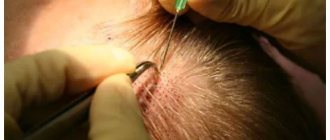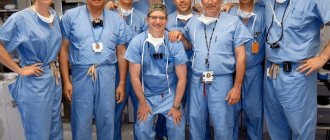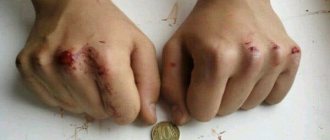During a mastopexy to correct ptosis, the doctor makes one of three types of incisions through which access is achieved. At the end of the operation, the incisions are closed with stitches. In the future, scars will appear in these places. Their visibility depends not only on the skill of the surgeon, but also on the individual characteristics of the patient and on the seriousness with which the patient approaches the care of the operated area during the rehabilitation period.
It is completely impossible to avoid scars, but you can make them completely invisible to the eyes of others and even to the patient herself. In some cases, special post-operative treatment, such as laser resurfacing, may help. But in most cases, it is possible to get by solely by following the doctor’s instructions during recovery.
Where are the scars located?
To gain access to the operated area, the surgeon makes one of the following types of incisions:
- periareolar,
- vertical,
- T-shaped (or anchor).
A periareolar incision is made along the edge of the nipple areola. With vertical access, an incision is added from the lower edge of the areola to the fold under the breast. Finally, the T-cut combines both of the previous incisions, plus an additional incision is made in the crease itself. This combination looks like an anchor, which is why the technique received the second name “anchor access”.
The mammoplasty technique is selected by the surgeon based on the degree of ptosis that the patient suffers from. For minor ptosis and naturally small breasts, a periareolar incision is optimal. If the ptosis is more severe, a vertical method will be required. For the most significant degree of prolapse, the use of a T-shaped incision is indicated.
Degree of ptosis.
What do stitches look like after a breast lift and how long do they take to heal?
Mastopexy is a popular plastic surgery that allows you to restore an attractive bust shape. During the intervention, the doctor excises and removes excess skin to lift the tissue and fix it in the desired position.
Sutures after a breast lift are inevitable, since this surgical procedure always involves incisions. How long they will take to heal and how noticeable the marks from them will be depends on a large number of factors, including. characteristics of the patient’s body and discipline.
Where exactly will the scars be? How long will it take for them to be finalized? what measures can be taken to make the scar less noticeable and what will help if you are not satisfied with its appearance? Our expert, plastic surgeon Ilya Vyachevslavovich Sergeev, helps you get answers to the most pressing questions at TecRussia.ru.
↑ What are the stitches after a lift and where are they located?
There are several options for mastopexy, they differ in the number and location of the incisions:
- Periareolar. The scalpel passes along the perimeter of the areola, resulting in a circular mark. This type of surgery is usually combined with the installation of breast implants.
- Vertical. The incision, as in the first case, runs along the edge of the pigmented area, and then descends vertically down to the inframammary fold. The effect of such a lift is more pronounced, but the seams are also more noticeable.
- T-shaped or anchor. It combines both previous methods; additionally, tissue is dissected in the fold under the breast. The most traumatic approach is used in cases of significant ptosis of the glands, when it is necessary to remove large excess sagging tissues.
Not even the most talented plastic surgeon can make sure that there are no traces of the operation left at all. The least noticeable scars remain after a periareolar lift, but this technique has limited indications for use.
Sergeev Ilya Vyacheslavovich Plastic surgeon, Candidate of Medical Sciences, leading specialist in breast plastic surgery at the DoctorPlastic clinic
An areola lift is almost always performed simultaneously with glandular enlargement. If correction is carried out without installing implants, the aesthetic result will be unsatisfactory - you will end up with so-called “tomato” breasts that are not very aesthetically shaped. In addition, the sagging of the bust should be insignificant. Otherwise, excision of excess skin will be required, which will result in the need for more incisions.
↑ How long does it take for stitches to heal?
Scar formation occurs differently in each patient and the duration of this process also varies greatly. Contrary to popular belief, the professionalism of the surgeon does not greatly affect the speed of healing. The main significant factors are different:
- General health condition, age of the patient - the older the woman, the slower the regeneration processes. Also, chronic pathologies and the presence of bad habits inhibit healing.
- The course of the postoperative period - if there are no complications, and the sutures are properly cared for, the tissues grow together more accurately and quickly.
- Compliance with the doctor’s recommendations during rehabilitation - if you violate the prohibitions on physical activity, abuse smoking or alcohol, or lift weights, the load on the intervention area will increase and healing will slow down.
On average, it takes about 1 year for a scar to fully mature. At this time, it goes through four main stages:
- Epithelization
– about 1-1.5 weeks. Immediately after the operation, the edges of the wound are connected with self-absorbing sutures that do not need to be removed, and with special strips or glues. After a few days, granulation tissue forms under them: it already holds the edges together, but is still very weak and can separate from any wrong movement. - Formation of a “young” scar
– 1 month. The fibers gradually become stronger, but due to their chaotic arrangement, the scar can look quite voluminous. At this stage, sudden movements, severe swelling, infection, and an individual reaction to the suture material can disrupt normal healing. As a result, the likelihood of wound divergence and the formation of a rough, sloppy scar increases. - Formation of a durable scar
– up to 3 months. Accompanied by further compaction of collagen and elastin fibers. They are aligned along the tension vector, due to this the volume of the scar is reduced, and by the end of the period it reaches maximum strength. At this stage, it is important to avoid excessive tension, pressure and physical impact on the wound area, so as not to provoke hypertrophy or the development of a keloid. - Full maturity
– from 1 year. The fibers take on their final structure, visually the scar becomes smaller and no longer protrudes above the surrounding tissues. Its color gradually changes - from red to almost white. This occurs by reducing the number of blood vessels. After about a year, you can evaluate the final appearance of the scar and, if necessary, plan correction.
↑ What could go wrong
The following factors can complicate healing and significantly worsen the appearance of scars after mastopexy:
- Suture dehiscence is the most unpleasant complication for the patient. The cause most often is improper fixation of tissues or sudden movements or stress in the pectoral muscle area. Even minimal opening of the edges of a postoperative wound threatens the development of an inflammatory process - as a result, healing is inhibited, and the scar enlarges and becomes rougher.
- Suppuration - occurs when a wound becomes infected. Any discharge from the stitches is a reason to be wary. But if purulent exudate appears, you cannot postpone a visit to the doctor; in advanced cases, this can lead to serious health problems, not to mention aesthetics. The cause of the complication usually lies in infection either during surgery or (more often) later due to improper wound care and failure to comply with the restrictions of the recovery period.
- Inflammation - can develop at any stage as a result of damage to the surface of the scar and the introduction of bacterial microflora. Accompanied by hyperemia, swelling, local pain, tissues are tense. Without timely treatment, suppuration may occur. Therefore, at the slightest suspicion of an inflammatory process, you must seek medical help.
- Pain, itching, pulling sensations, lumps in the suture area - as a rule, the symptoms are temporary and go away on their own. It is extremely important to be patient: do not rub or comb the developing scar. You need to notify your doctor only if the symptoms become severe and bother you for a long time.
Also, one of the most significant factors is the individual characteristics of the body. Even with an ideal operation and strict adherence to all recommendations, scars can look very different in different patients of the same surgeon. And for those whose scars have always healed quickly and accurately, unfortunately, it is impossible to guarantee the same in the future (if the surgeon promises everyone “thin, invisible stitches” in advance, this is nothing more than an advertising ploy).
Sergeev Ilya Vyacheslavovich Plastic surgeon, Candidate of Medical Sciences, leading specialist in breast plastic surgery at the DoctorPlastic clinic
Problems with suture healing can occur at any stage of scarring. But the highest risk of developing negative consequences is in the first 3-4 weeks. Normally, wounds heal quickly, and a neat and even scar appears at the site of excision. But the incompetence of the operating surgeon or violation of medical recommendations after the intervention can lead to negative consequences. Therefore, I advise you to be especially careful when choosing a clinic.
↑ How to avoid rough scars?
Every patient wants the trace of the intervention to remain almost invisible. To realize this desire, it is necessary to properly care for the sutures and follow the recommendations of the attending physician. It is especially important to follow these guidelines in the first few weeks:
- Be sure to wear compression underwear - it not only helps the breasts achieve the desired shape, but also puts the necessary pressure on the scar. This prevents wound divergence and promotes uniform healing.
- Refrain from bad habits - it makes sense to avoid smoking and drinking alcohol for at least a month, which worsen the regeneration process.
- Avoid visiting the solarium, beach, bathhouse and sauna - high temperatures and exposure to direct sunlight are contraindicated during the recovery period.
- Limit physical activity, sports - lifting weights, sudden movements of the arms or push-ups increase the load on the pectoral muscle. As a result, the likelihood of suture divergence and inflammation increases.
Sometimes, to speed up healing and make scars less noticeable, various wound-healing gels, ointments, and medicinal patches are used. But you shouldn’t “prescribe” and select them for yourself, without direct evidence - this is the exclusive prerogative of the doctor.
- Only silicone-based external products (for example, Dermatix) are proven to be highly effective. For reviews of some other anti-scarring drugs with their pros and cons, see the links: Contractubex, Fermenkol, Kelo-kot.
↑ How to deal with rough scars after a breast lift
If, after a year and a half, there are still voluminous scars at the intervention site, very different in color and texture from the surrounding skin, you can use cosmetic procedures to lighten and reduce the severity of the scars to correct them.
- The first step, as a rule, is laser resurfacing - it allows you to smooth out the scar and reduce its severity. Depending on the results the course gives, it is sometimes supplemented with mesotherapy injections and various types of peelings.
- The last resort is surgical removal of the scar. The essence of the operation is the excision of fibrous tissue and the subsequent connection of the edges of the dermis. As a rule, this method is used to combat rough, wide scars; in aesthetic surgery, such a need arises extremely rarely.
- Also, camouflage tattoos are gaining great popularity: a coloring pigment identical to the color of the surrounding skin is injected into the scar. This is a simple and effective way to make the scar from the operation minimally noticeable, there is only one limitation - it can be used only after the scar has completely formed (1-1.5 years after the operation).
What affects the appearance of scars?
How noticeable the scars will be after a breast lift primarily depends on the skill of the surgeon. The more experienced the doctor, the better the stitches will be placed and, accordingly, the less noticeable the scars.
But a doctor's qualifications alone are not enough. The severity of scars is also influenced by the individual characteristics of the patient herself. These include, for example, age. The older the patient, the lower the ability to regenerate. The production of collagen and other proteins necessary for tissue healing is significantly reduced, so the recovery rate and results will be slightly lower than in younger patients. In addition, some women have a natural tendency to form keloid scars, which also affects the appearance of the scars.
Finally, the severity of scars after surgery is also reflected in the care with which the patient approached breast care during the recovery period. Ignoring doctor's instructions, unfortunately, negatively affects the appearance of postoperative scars.
Are there any scars left after mammoplasty?
Women turn to a plastic surgeon not only to enlarge or reduce their breasts, correct asymmetry, or tighten the mammary gland. They want to see themselves and their lives differently. Therefore, after the patient has decided to undergo breast surgery, the first question she will have is about the stitches and the recovery period. Mammoplasty is a surgical procedure. And any surgical intervention implies scars and scars.
- How to minimize recovery time after mammoplasty?
- How long will there be scars on the chest? Which mammoplasty techniques will be the most comfortable?
How to properly care for your breasts so that the scars are invisible?
A breast lift will leave scars in any case, but it is up to the patient to make them less noticeable. To do this, you must follow the recommendations and prohibitions issued by the surgeon.
After breast lift surgery, special compression garments are put on the bust. It is strictly necessary to wear it, and around the clock. At first, you need to sleep only on your back, if possible in a reclining position (for this, use a high pillow or cushion under your back). For several months, visiting the gym, swimming pool, sauna, bathhouse, beach and solarium is prohibited. All types of physical activity, including housework, should be avoided.
It is advisable to give up bad habits for a month - alcohol, cigarettes. It is also recommended to avoid spicy foods. It is strongly recommended not to touch the chest unnecessarily, not to press on it, and to avoid any stress on the shoulder girdle area. Taking any medications, ointments, or medical procedures is possible only after consultation with a surgeon and his prescription. It is prohibited to choose your own medications.
Why do scars appear after mammoplasty?
Scars after breast surgery are caused by several factors:
1) Heredity . The most popular cause of scar formation, which the surgeon cannot influence. It is almost impossible to identify a genetic predisposition at the stage of preparation for surgery. If you feel like your skin is taking a long time to scar, be sure to tell your doctor.
2) Sloppy work of the surgeon. After mammoplasty, the plastic surgeon stitches up the incisions. If the specialist has insufficient experience, something may go wrong.
3) Poor quality suture material. Incorrectly selected threads can cause inflammation of the scar
4) Poor quality electrocoagulation. The process of “sealing” capillaries to stop bleeding can also cause scarring.
What to do if the scars are noticeable?
If the operation was performed by an experienced surgeon, and the patient was attentive in caring for herself and followed all the recommendations, then after the rehabilitation period, thin pale stripes remain on the skin, almost invisible to both others and the patient herself. But if for some reason the scars after a breast lift remain clearly visible, you can use some techniques to correct them.
Laser correction is an effective method of scar removal.
This includes, for example, hormonal injections, which are suitable for atrophic, hypertrophic and keloid scars. But their effect lasts for a year, no more. There are also silicone gels and patches. For a longer lasting effect, it makes sense to resort to laser resurfacing or chemical peeling, which give more pronounced results. It is not possible to completely get rid of scars, but you can make them almost invisible.
Finally, in the most difficult cases, you can resort to surgical correction, during which the old scar tissue is excised and a new suture is applied using a gentle technique. This method is effective for all types of scars.
Types of scars after mammoplasty
Scars after mammoplasty can be divided into three main types: 1) Normotrophic - the type of scars that remains after a successful operation. They have a light, barely noticeable appearance. They stretch well. 2) Hypertrophic - a type of scar that sometimes appears after surgery and should not worry the patient much. Most often it is temporary, the scars rise slightly above the skin level. 3) Keloid - scars that can be attributed to a complex healing process, but nevertheless, they are still temporary. With such scars, it is better to contact your doctor in advance. They protrude above the skin level and have irregularities.
How to avoid scars?
It is impossible to completely avoid traces of intervention. A breast lift leaves scars regardless of how well the stitches were placed. But the more experienced the surgeon, the more aesthetic the result will be.
The importance of the rehabilitation period cannot be underestimated. It is at this time that tissue healing occurs and scars form at the incision site. If you violate the surgeon’s instructions, use unauthorized means, ignore prohibitions, and so on, then the scars will be visible regardless of how well the operation was performed.
In most cases, if the recommendations are followed in combination with the skill of the surgeon, postoperative marks will be practically invisible. If this does happen, you can use existing methods for correcting scar tissue.
What types of seams are there?
Modern surgery has at its disposal various materials for fastening the edges of a postoperative wound to each other. The most common and reliable option is classic surgical sutures. They are made using a special needle and special thin but strong threads made of lavsan, vicryl, catgut and other materials. The tissues are sutured in layers, and a cosmetic suture is used for the skin. Thanks to a special technique, after the wound heals, a thin, barely noticeable line is formed, which is not noticeable at all. It is this technique that is used at the GALAXY Beauty Institute.
There are also fixation methods using surgical glue and metal staples, but they have not found use in plastic surgery because they do not provide sufficient reliability or aesthetics.
Indications for mastopexy
A breast lift is recommended for severe mastoptosis (prolapse and loss of firmness of the mammary glands). This condition is associated with aging of the body and a genetic predisposition to an early decrease in the elasticity of the skin. The rate of development of ptosis and its severity are influenced by the following factors:
- heredity;
- weight gain, then sudden loss;
- a large number of pregnancies (the more breast size changes during pregnancy, the greater the likelihood of sagging);
- smoking;
- poor quality bras;
- age.
A woman with congenital breast defects and nipple asymmetry may also need a lift. Breastfeeding does not significantly affect the development of mastoptosis.










